Lika-Senj County
Lika-Senj County (Croatian pronunciation: [lǐːka sɛ̂ːɲ], Croatian: Ličko-senjska županija) is a county in Croatia that includes most of the Lika region and some northern coastline of the Adriatic near the town of Senj, including the northern part of the Pag island. Its center is Gospić.
Lika-Senj County
Ličko-senjska županija | |
|---|---|
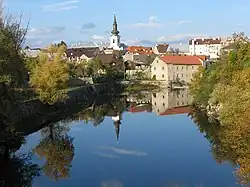 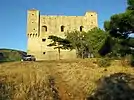      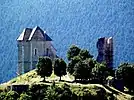 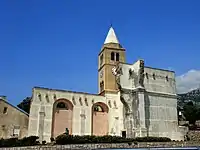 | |
 Flag 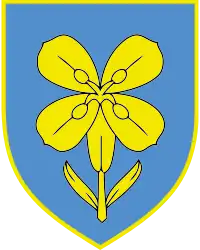 Coat of arms | |
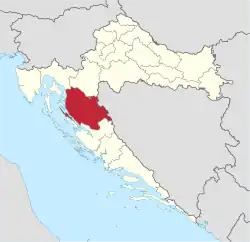 Lika-Senj County within Croatia | |
| Country | Croatia |
| County seat | Gospić |
| Government | |
| • Župan | Ernest Petry (HDZ) |
| Area | |
| • Total | 5,353 km2 (2,067 sq mi) |
| Population (2021)[2] | |
| • Total | 42,893 |
| • Density | 8.0/km2 (21/sq mi) |
| Area code | 053 |
| ISO 3166 code | HR-09 |
| HDI (2019) | 0.815[3] very high · 14th |
| Website | www |
The county is the least populated (44.625 in mid-2019) and among the least prosperous ones, though it is the largest county in the country by area and includes the Plitvice Lakes National Park and Sjeverni (North) Velebit National Park, some of Croatia's major tourist attractions.
Geography
The county has a total area of 5353 km2.
Administrative division
Lika-Senj County is administratively subdivided into 12 units of local government:
Demographics

|
| |||||||||||||||||||||||||||||||||||||||||||||||||||||||||
| Source: Naselja i stanovništvo Republike Hrvatske 1857–2001, Croatian Bureau of Statistics, Zagreb, 2005 | ||||||||||||||||||||||||||||||||||||||||||||||||||||||||||
Since the early 20th century the county's population has been shrinking. As of the 2021 census, the county had 42.893 residents. As of 2011 census, the county had 50,927 residents. The population density is 9.5/km2.
Croatian State Bureau of Statistics estimated population of the county to stand at 45,493 in 2017, 45,184 in 2018, and 44,625 in 2019.[4]
| population | 155467 | 165692 | 155382 | 170084 | 186871 | 182392 | 177055 | 172735 | 130855 | 125677 | 118329 | 106433 | 90836 | 85135 | 53677 | 50927 | 42893 |
| 1857 | 1869 | 1880 | 1890 | 1900 | 1910 | 1921 | 1931 | 1948 | 1953 | 1961 | 1971 | 1981 | 1991 | 2001 | 2011 | 2021 |
Ethnic composition
Ethnic Croats form the majority with 84.15% of the population, followed by Serbs at 13.65%.[5] Serbs form majority in municipalities of Vrhovine, Donji Lapac, and Udbina.
In 1991, before the outbreak of the Croatian War of Independence and the Breakup of Yugoslavia, Croats comprised 59.7% of the population, while Serbs comprised 37%. The area of the county used to have a significant Serb population, mostly located in the eastern part of the county, where they formed a majority. The entire former Lika-Krbava County, loosely overlapping with the area of the modern Lika-Senj county, in censuses of 1900 and 1910 even registered Serb majority (51.2% and 50.8%, respectively).
County government
The current Prefect of Lika-Senj County is Ernest Petry (HDZ).[6]
The county assembly is composed of 27 representatives from the following political parties:
| Political party | Seats won | Government |
|---|---|---|
| LiPO | 9 / 27 |
Opposition |
| Croatian Democratic Union | 6 / 27 |
Government |
| Croatian Party of Rights | 5 / 27 |
Government |
| Croatian Peasant Party | 2 / 27 |
Government |
| Croatian Party of Pensioners | 1 / 27 |
Government |
| Independent Democratic Serb Party | 1 / 27 |
Opposition |
| Croatian Bunjevac Party | 1 / 27 |
Government |
| Homeland Movement | 1 / 27 |
Opposition |
| Social Democratic Party of Croatia | 1 / 27 |
Opposition |
Minority councils and representatives
Directly elected minority councils and representatives are tasked with consulting tasks for the local or regional authorities in which they are advocating for minority rights and interests, integration into public life and participation in the management of local affairs.[7] At the 2023 Croatian national minorities councils and representatives elections Serbs of Croatia fulfilled legal requirements to elect 25 members minority council of the Lika-Senj County while Albanians and Bosniaks of Croatia fulfilled requirements to elect individual representative but with both representatives remaining unelected due to the absence of candidatures.[8] Some municipalities and towns in the county elected their own local minority councils as well.[8]
See also
- Lika-Krbava County of the Kingdom of Croatia-Slavonia
- Morlachia, an historical region in Europe largely located in the modern Lika-Senj County
References
- Ostroški, Ljiljana, ed. (December 2015). Statistički ljetopis Republike Hrvatske 2015 [Statistical Yearbook of the Republic of Croatia 2015] (PDF). Statistical Yearbook of the Republic of Croatia (in Croatian and English). Vol. 47. Zagreb: Croatian Bureau of Statistics. p. 62. ISSN 1333-3305. Retrieved 27 December 2015.
- "Population by Age and Sex, by Settlements, 2011 Census: County of Lika-Senj". Census of Population, Households and Dwellings 2011. Zagreb: Croatian Bureau of Statistics. December 2012.
- "Sub-national HDI - Area Database - Global Data Lab". hdi.globaldatalab.org. Retrieved 2021-07-19.
- "PROCJENA STANOVNIŠTVA REPUBLIKE HRVATSKE U 2019./POPULATION ESTIMATE OF REPUBLIC OF CROATIA, 2019". www.dzs.hr. Retrieved 2020-10-14.
- "Population by Ethnicity, by Towns/Municipalities, 2011 Census: County of Lika-Senj". Census of Population, Households and Dwellings 2011. Zagreb: Croatian Bureau of Statistics. December 2012.
- "Istarska županija: Župan i zamjenici župana". Archived from the original on 2020-08-14. Retrieved 2021-07-22.
- "Manjinski izbori prve nedjelje u svibnju, kreću i edukacije". T-portal. 13 March 2023. Retrieved 10 June 2023.
- "Informacija o konačnim rezultatima izbora članova vijeća i izbora predstavnika nacionalnih manjina 2023. IX. LIČKO-SENJSKA ŽUPANIJA" (PDF) (in Croatian). Državno izborno povjerenstvo Republike Hrvatske. 2023. p. 3. Retrieved 13 June 2023.
External links
- Official website
 (in Croatian)
(in Croatian)